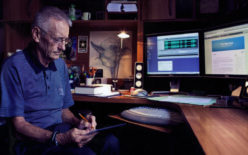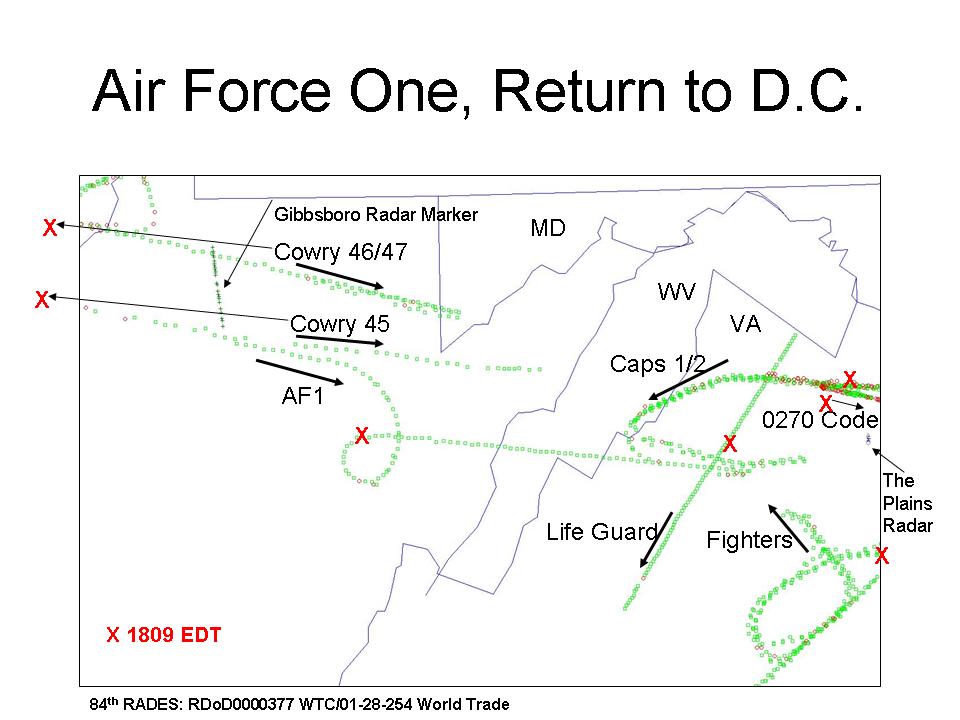Introduction
A correspondent asked me what I knew about the return flight of Air Force One to the nation’s capital. I had not previously looked at the event so turned to the primary source information to analyze the situation. Here is that analysis based on 84th Radar Evaluation Squadron radar files, air traffic control communications from the Federal Aviation Administration’s Washington Center (ZDC), and the audio files of the Northeast Air Defense Sector (NEADS). The story is interesting but uneventful. We begin with the radar files.
USAF Radar
Multiple aircraft are mentioned in the ZDC file, which we will discuss shortly. That discussion, however, requires a picture of where the relevant aircraft were spatially during the time that Air Force One was controlled by ZDC. I have selected a single time hack, 1809 EDT, to orient the reader.
At that time Air Force One was just completing a 360-degree turn, a holding pattern to allow its fighter escort, Cowry 45, 46 and 47, to catch up. Even so, ZDC informed Air Force One that the escort was 90 minutes in trail, the red Xes off the chart to the west.
Caps 1 and 2, the Andrews fighters tasked to escort Air Force One on the final leg, were well to the east and had just passed The Plains, Virginia. A Lifeguard flight, headed southwesterly, was accounted for, but did not impact the return flight.
A low level flight, Mode 3 code 0270 was discussed jointly by ZDC and NEADS; both agreed it had dropped off. The plane was broadcasting a Mode 2 code indicating it was military-related. The related target observed by NEADS and ZDC was at low level, 1200 feet and below and some of the returns were beacon only, not radar, hence the difficulty in tracking.
An additional pair of fighters, briefly mention by Mode 3 code, was to the south and circled back to the North and ultimately joined the escort of Air Force One.
Here is a screen shot of the 84th RADES radar file, annotated in powerpoint.
Washington Center (ZDC)
Air Force One was in ZDC airspace from 1800-1816 EDT as it returned the President to the nation’s capital. The check-in after handoff from Cleveland Center was routine. 1800 Air Force One Checks In (ZDC audio clips come from file 148-911-3007885A-s1.mp3, as archived by NARA in 2004)
At 1802 Air Force One requested a right 360 degree turn after which it would continue on course. That gradual turn, which covered considerable real estate when projected to the ground, served two purposes. First, as we shall shortly hear, it allowed fighter aircraft in trail to catch up. Second, it aligned Air Force One for a direct return just south of The Plains, Virginia, essentially parallel to Interstate I66. 1802 Right 360 Request Approved At 1803, ZDC notified an unidentified air traffic control entity (Linden?) about the 360-degree turn. 1803 Air Force One Doing a 360
At 1805 an Identification Technician at NEADS, Sergeant Lisa Raymond (digraph Lima Romeo), called to resolve Mode 3 code 0270. ZDC and NEADS agreed that the track had dropped out. It was sometimes a beacon-only (transponder return but not radar return) track at low altitude which may be why it “dropped out.” The conversation is an example of how NEADS routinely worked with FAA en route centers to resolve tracks of potential interest. Given the location and altitude the military-related aircraft, squawking a Mode 2 code, would have been under Dulles TRACON control and not ZDC. 1805 0270 Code NEADS ID Tech
Shortly thereafter, at 1806, two things happened simultaneously. First, Sergeant Richmond called asking why Air Force One was turning and heading the opposite direction. A background voice answered that “he is doing a 360 at his request.” Concurrently, Air Force One was calling the same controller with a request. That exchange tells us why Air Force One was turning. It was waiting for Cowry, a flight of three F-16s likely still under Cleveland Center control. The Air Force One cockpit voice asked that they be vectored to him. 1806 NEADS Concern and AF1 Request
Soon after 1807, ZDC provided an answer to Air Force One. Cowry 45 [flight lead] was 90 miles behind. 1807 Cowry 45 90 Miles Behind
A minute later, shortly after 1808 a Lifeguard flight made a routine check-in with ZDC. 1808 Lifeguard Flight Checks In
At 1810 two things came to the attention of the ZDC controller. First, Cowry 45 reported in and that he was “in the block” [tactical expression?] with Air Force One. Second, another controller informed that a pair of fighters out of the national area were coming that way to “intercept the group.” Here the term “intercept” simply means to join up. They did just that as clearly shown on the depiction of the radar files. They flew out, spotted and identified the aircraft, and then joined to escort Air Force One. 1810 Cowry 45 Check In Other Fighters Mentioned
At 1812 the controller was informed by another sector of the presence of a different fighter and that “they know about it.” That report referred to the second pair of fighters that joined the escort of Air Force One from the south, as depicted in the lower right of the graphic, above. 1812 Other Fighter Reported
In the 1812-1814 time frame several things happened. First, Cowry 47 reported in asking for a squawk [Mode 3] and that he was information with Cowry 45. Second, Cowry 47 confirmed the approach of the fighters [085 direction] from the DC area. Third, the Life Guard flight was informed and acknowledged the presence of military aircraft. (The discussion about “Uniform” had to do with a division of labor among the Cowry flight as to who was going to monitor what frequency in which band. A similar discussion had taken place eight hours earlier when another flight of three fighters, the Quit flight from Langley, also approached the nation’s capital.) 1813 Cowry 47 Other Fighters Life Guard
At 1816 Air Force One was handed off routinely to Dulles TRACON. 1816 Air Force One Contact Dulles Other than a sweeping 360-degree turn to allow escorting fighters to catch up, it was an uneventful flight according to the available air traffic control communications, a primary source. But we also have available additional primary source audio files, those of NEADS.
Northeast Air Defense Sector (NEADS)
NEADS began tracking Air Force One well before the flight entered ZDC airspace. At 1730 EDT the track (B001) and altitude (33000) were reported to Master Sergeant Maureen Dooley (“Mo”) The technician making the report did not observe any fighters. He was told the track was being forward told, now, a probable reference to passing the track to Cheyenne Mountain. 1730 Track B001 Air Force One (Channel 4, DRM1, cut 210926) Immediately, NEADS personnel decided that, according to NORAD, Air Force One was going to Andrews. 1730 Going to Andrews (Channel 4, DRM 1, cut 211022)
The NEADS tapes reveal that the first team was on duty as inferred by the reference to Sergeant Dooley. In this next clip in the 1740 time frame we hear the voices of both the Mission Crew Commander, Major Nasypany, and the Senior Director, Major Fox. There was an issue about a Mode 3 unknown 40 miles south of Air Force One which was resolved to be the “Omaha” flight. 1747 Some Familiar Voices (Channel 2, DRM 1 cut 212211)
Shortly after Air Force One checked in with ZDC NEADS controllers were aware of the position and were asking themselves where the fighter escort was. They did not know. 1801 Wheres Fighter Escort We know from the ZDC tape that the fighters were well to the west, but NEADS did not yet know they were in trail. (Channel 2, DRM 1, cut 212211)
By 1805, the observation on radar that Air Force One got NEADS attention. This next clip, over two minutes long, captures how Major Nasypany handled that situation. He is listening to multiple positions on the NEADS floor, but Sergeant Raymond’s voice comes through loud and clear when she reports that Air Force One is orbiting at the President’s request. 1805 Orbiting at the Presidents Request (Channel 2, DRM 1 cut 212211)
For the record, here is the continuous conversation between Sergeant Raymond and ZDC concerning both the 0270 zero code and Air Force One. The NEADS tapes provided to the Commission end on all channels shortly after 2208Z. 1805 Raymond and ZDC AF One
Observation
Although it appears from the radar picture that Air Force One was unescorted while in ZDC airspace the tactical picture suggests otherwise. The Cowry flight of three was present to the west (trailing) and north. The escorting fighters from the long-established DC Combat Air Patrol were present to the east and south. In addition, there were two E3’s airborne, one in the Chicago area and one in the DC area.
I will eventually get around to telling the E3 story, one that spreads across most postions and recorded channels at NEADS. The E3, in effect, mirrored and supported NEADS. Each had a Mission Crew Commander working under the overall direction of Major Nasypany, the Mission Crew Commander at NEADS

